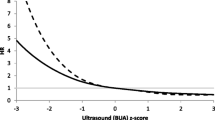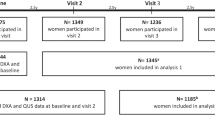Abstract
Osteoporotic fracture is considered to result from reduced bone strength and to be related to decreased bone mass and impaired bone architecture. Quantitative ultrasound measurements (QUS) of bone, that may reflect certain architectural aspects of bone, have been shown to be associated with fracture, but it is not clear whether the association is independent of bone mineral density (BMD). This study was designed to examine the contributions of cortical QUS and BMD measurements to the prediction of fracture risk in postmenopausal Caucasian women. Speed of sound (SOS) at the distal radius, tibia, and phalanx (Sunlight Omnisense) and BMD at the lumbar spine and femoral neck (GE Lunar) were measured in 549 women, aged 63.2 ± 12.3 years (mean ± SD; range, 49–88 years), including 77 fracture cases. Lower SOS at the distal radius, tibia, and phalanx, which were correlated with each other, were associated with increased risk of fracture. Independent predictors of fracture risk (in multivariate analysis) were distal radius SOS (OR per SD = 1.8; 95% CI, 1.3–2.4), femoral neck BMD (OR per SD = 1.9; 95% CI, 1.4–2.4), and age (OR per 5 years = 1.2; 95% CI, 1.0–1.5). Approximately 30% of the women had distal radius SOS T-scores <−2.5; however, only 6.6% of women had both BMD and SOS T-scores <−2.5. Among the 77 fracture cases, only 14 (18.2%) had both BMD and QUS T-scores below −2.5. These data in postmenopausal women suggest that speed of sound at the distal radius was associated with fracture risk, independent of BMD and age. The combination of QUS and BMD measurements may improve the accuracy of identification of women who will sustain a fracture.


Similar content being viewed by others
References
Hui SL, Slemenda CW, Johnston CC Jr (1989) Baseline measurement of bone mass predicts fracture in white women. Ann Intern Med 111:355–361
Nguyen T, Sambrook P, Kelly P, Jones G, Lord S, Freund J, Eisman J (1993) Prediction of osteoporotic fractures by postural instability and bone density. BMJ 307:1111–1115
Marshall D, Johnell O, Wedel H (1996) Meta-analysis of how well measures of bone mineral density predict occurrence of osteoporotic fractures. BMJ 312:1254–1259
Kaufman JJ, Einhorn TA (1993) Ultrasound assessment of bone. J Bone Miner Res 8:517–525
Turner CH, Peacock M, Timmerman L, Neal JM, Johnston CC (1995) Calcaneal ultrasonic mneasurements discriminate hip fracture independent of bone mass. Osteoporos Int 5:130–135
Schott AM, Weill-Engerer S, Hans D, Duboeuf F, Delmas PD, Meunier PJ (1995) Ultrasound discriminates patients with hip fracture equally well as dual energy X-ray absorptiometry and independent of bone mineral density. J Bone Miner Res 10:243–249
Glüer CC, Cummings SR, Bauer DC, Stone K, Pressman A, Mathur A, Genant HK (1996) Osteoporosis: association of recent fractures with quantitative ultrasound findings. Radiology 199:725–732
Bauer DC, Gluer CC, Cauley JA et al (1997) Broadband ultrasound attenuation predicts fractures strongly and independently of densitometry in older women: a prospective study. Study of Osteoporotic Fractures Research Group. Arch Intern Med 157:629–634
Hans D, Dargent MP, Schott AM et al (1996) Ultrasonographic heel measurements to predict hip fracture in elderly women: the EPIDOS prospective study. Lancet 348(9026):511–514
Frost ML, Blake GM, Fogelman I (2000) Does quantitative ultrasound enhance precision and discrimination? Osteoporos Int 11:425–433
Nguyen TV, Center JR, Eisman JA (2000) Osteoporosis in elderly men and women: effects of dietary calcium, physical activity and body mass index. J Bone Miner Res 15:322–331
Nguyen TV, Sambrook PN, Eisman JA (1997) Source of variability in bone density: implication for study design and analysis. J Bone Miner Res 12:124–135
Hans D, Srivastav SK, Singal C, Barkmann R, Njeh CF, Kantorovich E, Gluer CC, Genant HK (1999) Does combining the results from multiple bone sites measured by a new quantitative ultrasound device improve discrimination of hip fracture? J Bone Miner Res 14(4):644–651
Kass RE, Raftery AC (1995) Bayes factors. JASA 90:773–795
Kanis JA (2002) Diagnosis of osteoporosis and assessment of fracture risk. Lancet 359(9321):1929–1936
Kleerekoper M, Villaneuva AR, Stanciu J, Rao DS, Parfit AM (1985) The role of three dimensional trabecular microstructure in the pathogenesis of vertebral compression fracture. Calcif Tissue Int 37:594–597
Langton CM, Palmer SB, Porter RW (1984) The measurement of broadband ultrasonic attenuation in cancellous bone. Eng Med 13:89–91
Langton CM, Evans GP (1991) Dependence of ultrasonic velocity and attenuation on the material properties of cancellous bone. Osteoporos Int 1:194
Gregg EW, Kriska AM, Salamone LM, Roberts MM, Anderson SJ, Ferrell RE, Kuller LH, Cauley JA (1997) The epidemiology of quantitative ultrasound: a review of the relationships with bone mass, osteoporosis and fracture risk. Osteoporos Int 7:89–99
Pluijm SMF, Graafmans WC, Bouter LM, Lips P (1999) Ultrasound measurements for the prediction of osteoporotic fractures in elderly people. Osteoporos Int 9:550–556
Ross P, Huang C, Davis J, Imose K, Yates J, Vogel J, Wasnich R (1995) Predicting vertebral deformity using bone densitometry at various skeletal sites and calcaneus ultrasound. Bone 16:325–332
Graafmans WC, Van Lingen A, Ooms ME, Bezemer PD, Lips P (1996) Ultrasound measurements in the calcaneus: precision and its relation with bone mineral density of the heel, hip, and lumbar spine. Bone. 19:97–100
Acknowledgements
We gratefully acknowledge the expert assistance of Janet Watters and Donna Reeves in the interview, data collection, and bone densitometry; and the invaluable help of the staff of Dubbo Base Hospital. This work has been supported by the National Health and Medical Research Council of Australia. We also thank the generous support of Sunlight Ultrasound Technologies, the maker of the Omnisense ultrasound instrument, for this study.
Author information
Authors and Affiliations
Corresponding author
Rights and permissions
About this article
Cite this article
Nguyen, T.V., Center, J.R. & Eisman, J.A. Bone mineral density-independent association of quantitative ultrasound measurements and fracture risk in women. Osteoporos Int 15, 942–947 (2004). https://doi.org/10.1007/s00198-004-1717-z
Received:
Accepted:
Published:
Issue Date:
DOI: https://doi.org/10.1007/s00198-004-1717-z




